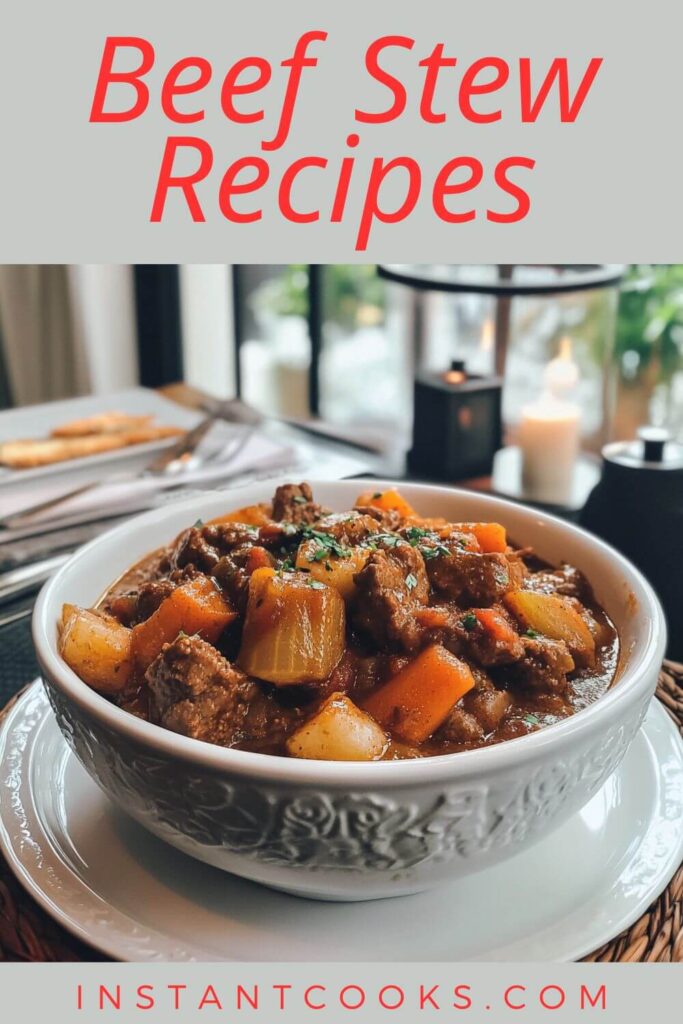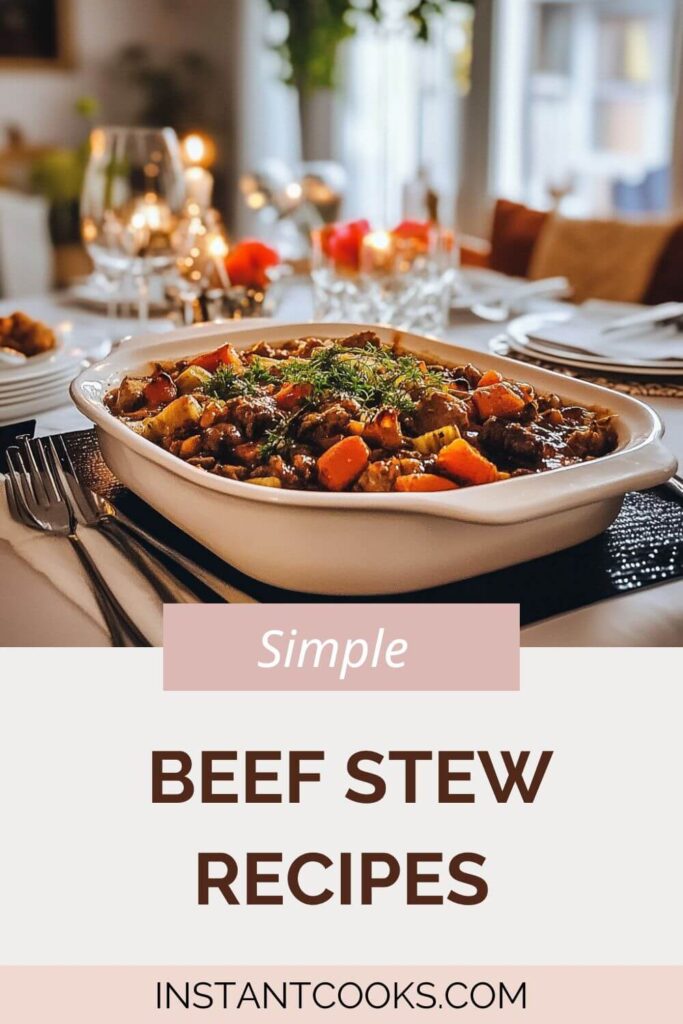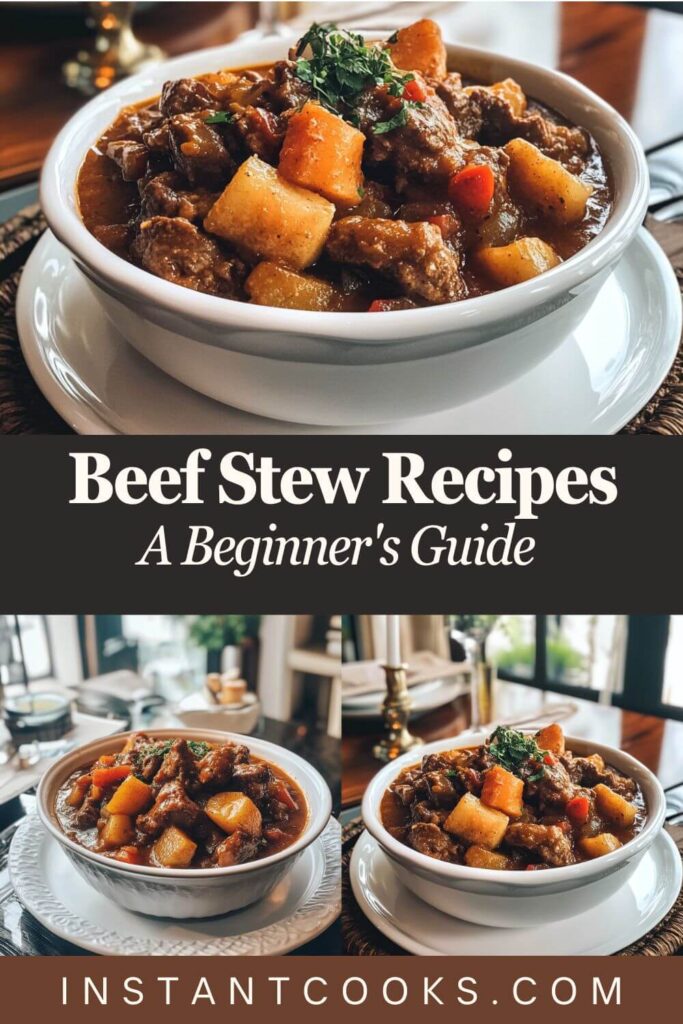Beef stew recipes have stood the test of time as one of the most beloved dishes around the world. Whether you’re preparing it for a cozy family dinner or serving it to guests, there’s something magical about tender beef, hearty vegetables, and rich, flavorful broth coming together in a pot. With a perfect balance of simplicity and sophistication, this dish is both accessible to beginners and rewarding for experienced cooks.
When you think of comfort food, beef stew is likely to top the list. It’s the kind of dish that brings warmth and satisfaction to any chilly evening. In this article, we’ll explore how to make the perfect beef stew, highlighting essential ingredients, step-by-step instructions, and helpful tips to ensure that your stew turns out every bit as comforting and flavorful as you expect.
What Makes Beef Stew So Special?
Before diving into the specifics of preparing beef stew, it’s important to understand what makes it such a timeless dish. A well-made beef stew is all about balance – from the choice of beef to the seasonings and the slow cooking process. Here are some key factors that elevate beef stew:
Tender Beef: The quality of the beef is essential. Chuck roast or brisket are popular choices due to their marbling, which ensures tenderness after long, slow cooking.
Rich Broth: The broth, made with a combination of wine, broth, and aromatic herbs, is the soul of the stew. It develops rich, savory flavors as it simmers with the meat and vegetables.
Vegetables: Carrots, potatoes, and onions are the typical accompaniments, adding sweetness and texture to balance the savory meat.
Slow Cooking: The long cooking time allows the beef to become incredibly tender and infused with the flavors of the broth, making the stew more than just a meal but an experience.
Ingredients for a Classic Beef Stew Recipe
When preparing a beef stew, it’s crucial to use the right ingredients to ensure depth of flavor and perfect texture. Here’s a breakdown of the essential ingredients for a traditional beef stew:
Key Ingredients
- Beef Chuck Roast (or Brisket): Look for well-marbled cuts of beef. The fat running through the meat will melt and add richness to the stew. Avoid lean cuts like sirloin, as they won’t be as tender.
- Olive Oil: This will be used to brown the beef and sauté the vegetables. A good quality olive oil adds a subtle depth to the dish.
- Yellow Onions & Garlic: These aromatics serve as the flavor base. The sweetness of the onions pairs beautifully with the richness of the beef.
- Carrots: Add natural sweetness and color to the stew.
- Potatoes: Baby Yukon Gold potatoes are ideal as they hold their shape well and soak up the flavors of the broth.
- Dry Red Wine: A dry red wine, such as Cabernet Sauvignon, Merlot, or Pinot Noir, adds acidity and complexity to the stew.
- Beef Broth & Water: These form the liquid base of the stew, absorbing the flavors from the meat and vegetables.
- Herbs & Seasonings: Bay leaves, thyme, and a bit of sugar enhance the overall flavor profile.
- Flour: A small amount of flour is used to thicken the broth, creating a luxurious, velvety sauce.
Optional Ingredients
- Tomato Paste: This can add extra depth and umami to the flavor.
- Balsamic Vinegar: Adds a touch of acidity to balance the richness of the stew.
- Fresh Parsley: For garnish, parsley adds a burst of color and freshness to finish the dish.
These ingredients come together to create a stew that’s hearty, comforting, and packed with flavor. However, there are variations and substitutions that can tailor the recipe to your personal taste. For example, you can swap in different vegetables like parsnips or turnips, or experiment with different herbs for a unique flavor profile.
Helpful Tip: Choosing the Right Beef Cut
The best beef stew starts with the right cut of meat. Chuck roast is generally considered the best choice because of its marbling. As the stew simmers, the fat breaks down and infuses the broth with flavor. If you don’t have chuck roast, brisket or round roast are acceptable substitutes, though they may not be quite as tender. Avoid using lean cuts like sirloin or tenderloin, as they can become tough during the slow cooking process.

Preparing Beef Stew: Step-by-Step Instructions
Making beef stew is more of a slow process than a fast one, but don’t let that intimidate you. The long cooking time allows the flavors to meld together and the beef to become perfectly tender. Below is a straightforward, step-by-step guide to making your own beef stew.
Step 1: Brown the Beef
Start by cutting your beef into 1½-inch pieces. Pat the pieces dry with a paper towel—this will help them brown more effectively. Season the beef generously with salt and freshly ground black pepper. Heat a tablespoon of olive oil in a large Dutch oven or heavy-bottomed pot over medium-high heat.
Once the oil is hot, brown the beef in batches. It’s important not to crowd the pan, as this will cause the beef to steam rather than brown. Let each batch brown for 4-5 minutes on all sides, then transfer the beef to a plate and set it aside.
Pro Tip: Browning the beef is a crucial step that adds depth to the flavor of the stew. Don’t rush it!
Step 2: Sauté the Vegetables
In the same pot, add another tablespoon of olive oil if needed. Add the chopped onions and garlic, and sauté for about 3-4 minutes until softened and fragrant. The garlic should be lightly golden, not burnt.
At this point, you can add a tablespoon of balsamic vinegar to the pot. This will help loosen the browned bits stuck to the bottom of the pot, adding even more flavor to your stew.
Step 3: Build the Flavor Base
Once the onions and garlic have softened, stir in the tomato paste and cook for 1 minute to intensify the flavor. Sprinkle in the flour and stir well to combine. The flour will help thicken the stew as it simmers.
Now, return the browned beef to the pot. Add your dry red wine, beef broth, water, bay leaves, thyme, and sugar. Stir to combine and bring the mixture to a boil.
Step 4: Slow Cook the Stew
Once the stew comes to a boil, cover the pot and place it in a preheated oven at 325°F (165°C). Braise the stew for 2 hours. If you don’t have a Dutch oven, you can cook the stew on the stovetop over low heat. Just be sure to stir occasionally to prevent sticking.
Step 5: Add the Vegetables
After 2 hours, it’s time to add the carrots and potatoes. Stir them into the stew, cover the pot, and return it to the oven for another hour, or until the beef is tender and the vegetables are cooked through.
Optional: For a thicker broth, you can create a flour-butter paste and stir it in during the last 30 minutes of cooking. This will help thicken the stew and give it a velvety texture.
Step 6: Final Touches
Once the stew is done, remove the pot from the oven. Taste the stew and adjust seasoning with salt and pepper as needed. Discard the bay leaves before serving. Serve your beef stew hot, garnished with fresh chopped parsley for a burst of color.
Pro Tip: This stew is even better the next day, as the flavors continue to develop. Let it cool, store it in the refrigerator, and reheat it the following day for a richer experience.
Beef Stew Recipes: A Heartwarming Comfort Food for Any Occasion
Beef stew is a classic dish that resonates with comfort, warmth, and simplicity. Whether you’re preparing it for a cozy family dinner or a hearty meal for friends, beef stew recipes are versatile, rich in flavor, and easy to tweak to your personal tastes. In this guide, we’ll explore how to make a perfect beef stew, step by step, offering variations and tips to elevate the dish.
What Makes Beef Stew So Special?
Beef stew stands out as one of the best comfort foods, offering hearty flavors and a satisfying combination of tender beef, vegetables, and a rich broth. But what truly makes this dish shine is the slow-cooked process, where the beef becomes meltingly tender and the flavors meld together into a delicious harmony. It’s perfect for colder months or anytime you need a filling, flavorful meal.

Key Ingredients in Beef Stew Recipes
To craft the ultimate beef stew, there are a few key ingredients you cannot skip. Each component plays a vital role in building the flavors, textures, and richness of the dish.
1. Beef
Beef chuck is the most popular cut used in stew recipes. It’s well-marbled with fat, which helps it break down into tender, juicy pieces as it cooks. You can also use brisket or round, but chuck is the best for its tenderness and flavor. Avoid using lean cuts like sirloin or round, as they tend to become tough and dry when cooked for long periods.
2. Vegetables
Carrots, potatoes, onions, and garlic are the classic vegetable additions in beef stew. Carrots provide natural sweetness, while potatoes help thicken the stew and soak up the savory broth. Onions and garlic bring depth and aroma to the dish.
3. Broth and Wine
A good beef broth is crucial for creating the stew’s base. Opt for low-sodium beef broth to maintain control over the stew’s saltiness. For an extra depth of flavor, a dry red wine, such as Cabernet Sauvignon or Merlot, complements the richness of the beef and vegetables.
4. Herbs and Aromatics
Bay leaves, thyme, and rosemary are common herbs that infuse earthy flavors into the stew. Garlic, in addition to providing flavor, helps bind all the ingredients together. A touch of balsamic vinegar adds acidity and a little tang, balancing the richness of the dish.
Step-by-Step Instructions for Making Beef Stew
Now that we’ve gathered all the essential ingredients, let’s dive into how to make this wonderful beef stew recipe. Whether you’re using a Dutch oven, stovetop, or slow cooker, these steps will ensure your beef stew turns out perfectly every time.
Ingredients List
- 3 pounds beef chuck (cut into 1.5-inch cubes)
- 2 teaspoons salt
- 1 teaspoon black pepper
- 2 tablespoons olive oil
- 2 medium onions (roughly chopped)
- 5 cloves garlic (peeled and smashed)
- 1 tablespoon balsamic vinegar
- 1.5 tablespoons tomato paste
- 2 tablespoons all-purpose flour
- 2 cups dry red wine
- 2 cups beef broth
- 2 cups water
- 1 bay leaf
- 1 teaspoon dried thyme
- 4 large carrots (peeled and cut into chunks)
- 1.5 pounds baby potatoes (halved)
- Fresh parsley for garnish (optional)
Instructions
Prepare the Beef: Begin by trimming any large chunks of fat from the beef. While you don’t want to remove all the fat, leaving some helps to tenderize the meat. Season the beef generously with salt and pepper.
Brown the Meat: Heat the olive oil in a Dutch oven or large pot over medium-high heat. Brown the beef in batches, making sure not to crowd the pot. Browning the beef adds rich, savory flavor to the stew, so take your time to get a good sear on all sides.
Sauté Aromatics: Once all the beef is browned and set aside, add the onions and garlic to the pot. Cook them for a few minutes until softened and fragrant, scraping the brown bits from the bottom of the pot with a wooden spoon.
Deglaze the Pot: Pour in the balsamic vinegar to deglaze the pot, scraping up any remaining browned bits from the bottom. This step adds additional flavor depth. Then stir in the tomato paste and cook for a minute or two to allow it to caramelize slightly.
Add Liquids and Herbs: Add the flour to the pot and stir until it’s absorbed. Pour in the wine, beef broth, and water, then add the bay leaf and thyme. Stir everything together, ensuring there are no lumps of flour. Bring the mixture to a boil.
Simmer the Beef Stew: Reduce the heat to low, cover the pot, and let it simmer for about 2 hours. During this time, the beef will become tender, and the flavors will meld together. If using a stovetop, ensure the heat is low to prevent burning and stir occasionally.
Add the Vegetables: After 2 hours, add the carrots and potatoes to the pot. Stir everything together, cover again, and let it cook for another hour until the vegetables are tender, and the broth has thickened.
Final Adjustments: Taste the stew and adjust the seasoning if necessary. If you like a thicker stew, you can mash a few potatoes directly in the pot to thicken the broth. Alternatively, you can prepare a slurry of flour and butter to add at the end to give the stew a velvety texture.
Variations of Beef Stew Recipes
While the basic beef stew recipe is always a crowd-pleaser, there are several variations that can elevate the dish even further. Here are a few ideas to personalize your beef stew:
Spicy Beef Stew: Add red pepper flakes or a chopped jalapeño to the stew base to introduce some heat. You can also add a bit of smoked paprika for extra flavor.
Herb-Infused Beef Stew: In addition to thyme and bay leaves, try adding rosemary, sage, or even a small bunch of fresh parsley for a more herbal profile.
Creamy Beef Stew: For a creamier version, add a splash of heavy cream towards the end of the cooking process. This gives the stew a luxurious texture.
Vegetarian Option: Substitute the beef for hearty vegetables like mushrooms, parsnips, and root vegetables to create a rich, vegetarian-friendly stew.
Cooking Methods for Beef Stew
You can make beef stew using various cooking methods, depending on your preferences and the equipment you have available.
1. Traditional Dutch Oven or Stovetop Cooking
The stovetop method is straightforward, and a Dutch oven is ideal for evenly distributing heat. After browning the beef and sautéing the aromatics, simply simmer the stew on low heat for several hours until the beef is tender.
2. Slow Cooker
If you prefer a hands-off approach, a slow cooker is a great option. Brown the meat and sauté the onions and garlic, then transfer everything to the slow cooker along with the remaining ingredients. Cook on low for 7-8 hours or high for 4-5 hours. The result is tender beef and a rich, flavorful stew.
3. Instant Pot or Pressure Cooker
For a faster version, an Instant Pot or pressure cooker works well. Follow the same steps but reduce the cooking time. In about 45 minutes to an hour, you can have a beef stew that’s just as tender and flavorful.
Serving Suggestions and Leftover Ideas
Beef stew recipes are the gift that keeps on giving. Not only are they hearty and satisfying when freshly made, but they also transform beautifully into delicious leftovers. Whether you’re serving a comforting meal to your family or finding creative ways to repurpose your stew, the possibilities are endless. Let’s dive into some serving and leftover ideas that will make every bite count!
Perfect Pairings for Beef Stew
A good beef stew doesn’t need much to shine, but pairing it with the right sides can elevate the meal. Here are some ideas to complete your dish:
- Crusty Bread: There’s something magical about dunking a piece of warm, crusty bread into the rich broth. It soaks up every drop of flavor and adds a delightful crunch to each bite.
- Mashed Potatoes: For a double dose of comfort, serve your stew over a bed of creamy mashed potatoes. The broth acts like a flavorful gravy, turning this pairing into a match made in heaven.
- Rice or Quinoa: If you’re looking for a lighter option, steamed rice or fluffy quinoa works perfectly. It absorbs the stew’s flavors and adds a nutty undertone to the dish.
- Buttered Egg Noodles: For a nostalgic touch, ladle your stew over buttery egg noodles. It’s like a hug in a bowl!
Leftover Magic
Don’t let a single spoonful of your beef stew go to waste. With a little creativity, you can transform leftovers into brand-new dishes:
- Pot Pies: Pour your stew into a pie dish, top it with a layer of puff pastry or biscuit dough, and bake until golden brown. Voilà—a hearty beef pot pie that feels like a whole new meal.
- Tacos: Shred the beef and spoon it into warm tortillas. Add a dollop of sour cream, a sprinkle of cheese, and some fresh cilantro for an unexpected twist on taco night.
- Shepherd’s Pie: Use the stew as the base, spread a layer of mashed potatoes on top, and bake until the potatoes are golden and slightly crispy. This is comfort food on another level.
- Hearty Soup: Add some extra broth or diced tomatoes to turn your stew into a warming soup. Toss in some pasta or barley for added texture.
- Freezer-Friendly Meal: Beef stew freezes like a dream. Portion it into individual containers for an easy, homemade meal on busy nights. Just reheat and enjoy!
Pro Tips for Reheating Leftovers
- On the Stovetop: Heat the stew gently over low heat, stirring occasionally to prevent sticking. Add a splash of broth or water if the stew has thickened too much.
- In the Microwave: Place a portion in a microwave-safe dish, cover loosely, and heat in short intervals, stirring in between to ensure even warming.
- In the Oven: If you’re reheating a large batch, place the stew in a covered oven-safe dish and heat at 350°F (175°C) until warmed through.
With these serving suggestions and leftover ideas, your beef stew recipes will never feel repetitive. From fresh-out-of-the-pot meals to reinvented creations, you’ll savor every last bite. So go ahead, make a big batch—you’ll be glad you did!
FAQ List for the Article
1. Can I make beef stew without a slow cooker or Instant Pot?
Yes, you can make beef stew on the stovetop! Brown the beef, sauté vegetables, add broth, and simmer on low for 1.5-2 hours, stirring occasionally for a rich and flavorful dish.
2. What is the best cut of meat for beef stew?
The best cuts for beef stew include chuck roast, brisket, or short ribs. These cuts are affordable and become tender and flavorful when slow-cooked, making them ideal for rich, hearty stews.
3. How can I make beef stew in an Instant Pot?
To make beef stew in an Instant Pot, brown the beef, add vegetables, broth, and seasonings, and pressure cook for 30-40 minutes. This method creates tender meat and flavorful broth quickly.
4. Can I freeze beef stew?
Yes, beef stew freezes well! Portion it into airtight containers and store it in the freezer for up to three months. Thaw in the refrigerator overnight and reheat gently on the stovetop or microwave.
5. What vegetables go well in beef stew?
Classic vegetables for beef stew include carrots, potatoes, onions, and celery. You can also add mushrooms, peas, or sweet potatoes for added flavor and variety.
6. How do I thicken beef stew?
Thicken beef stew by adding a cornstarch slurry (mix cornstarch and water), mashing some cooked potatoes, or using a flour-based roux. Stir it into the stew until you reach the desired consistency.
7. What seasoning should I use for beef stew?
Season beef stew with salt, black pepper, garlic, thyme, rosemary, and bay leaves. For extra flavor, try smoked paprika, red wine, or a splash of balsamic vinegar.
8. How long does it take to cook beef stew in a slow cooker?
Cook beef stew in a slow cooker on low for 6-8 hours or on high for 3-4 hours. The long cooking time ensures tender beef and rich flavors.
9. What are creative ways to serve leftover beef stew?
Turn leftover beef stew into pot pies, shepherd’s pie, or serve it over rice, noodles, or mashed potatoes. You can also use it as a filling for tacos or freeze it for later use.







